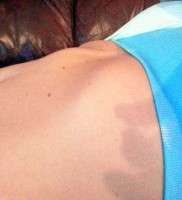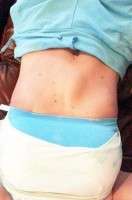Tummy tuck diastasis recti repair
Although it is possible to repair your diastasis recti with endoscopic techniques through several small incisions, you would most likely be best served with a mini tummy tuck.
A partial tummy tuck will allow not only for the repair of your separated muscles but will also help treat any excess skin that may become apparent after such a repair in a way that endoscopic tummy tuck alone would not.
This is a common surgery in my practice with patients that are then but have separated recti muscles and stretch marks centrally. (Pat Pazmino, MD, Miami Plastic Surgeon)
Benefits of a full tummy tuck diastasis recti repair
Depending on the severity and complexity of the case, you will mostly benefit from a standard (full) tummy tuck. A standard tummy tuck involves mucle repair and removal of the loose excess skin. Muscle repair includes tightening the muscles stretched from pregnancy, giving you the hour glass figure and improving your waistline.
A mini tummy tuck only involves repair of the muscles from the belly button down. This will give you a result, but not a longer-lasting result.
Find a board certified plastic surgeon to consult with regarding your concerns and discuss your best and safest possible options. Please check out before and after photos of patients. (Tom J. Pousti, MD, FACS, San Diego Plastic Surgeon)
Tummy tuck not required for diastasis recti repair
A diastassis recti is the separation of your abdominal muscles. the skin can be lifted alone to repair this. Removal of skin is optional, but if the excess is there, it should be removed for a better appearance. (Barry E. DiBernardo, MD, Montclair Plastic Surgeon)
Bringing the muscles back together is a major component of a “standard” tummy tuck, the other part being removal of excess skin. There are different versions of “mini” tummy tucks, one of which would fix your diastasis.
When people refer to a mini tummy tuck, they are talking about the visible tummy tuck scar being shorter than a standard tummy tuck. With a mini, the scar is the length of a c-section scar, and standard is hip-bone to hip-bone. If your surgeon uses the endoscope, your diastasis can be repaired through a mini scar.
Although this is possible, most patients would still really benefit from the major change afforded by resetting skin tone that is possible with the standard incision length. There are many excellent Board Certified plastic surgeons in NYC – visit with one and discuss your goals, and get their opinions regarding your options. (Michael A. Bogdan, MD, FACS, Dallas Plastic Surgeon)
Full tummy tuck to repair diastasis recti.
If you indeed have a prominant amount of diastasis recti I would recommend a full tummy tuck for best results. Consult a board certified plastic surgeon who is experienced in the tummy tuck procedure. Good luck to you. (Jaime Perez, MD, Tampa Plastic Surgeon)
Tummy tuck diastasis recti repair
For the degree of diastasis (separation) you describe, it certainly sounds like a full tummy tuck, or abdominoplasty would be required. An abdominoplasty generally includes repair of the diastasis of the rectus muscles, removal of any skin excess, and liposuction of the upper abdomen and flanks.
Patients vary greatly as to which of these three components they will derive the greatest benefit from. (Glynn Bolitho, PhD, MD, FACS, San Diego Plastic Surgeon)
Is a Tummy Tuck Required to Fix Diastasis Recti?
Yes, the only way to gain access to the full abdominal wall in order to repair any significant diastasis recti is by a full tummy tuck. A lower tummy tuck does not offer access to the upper tummy, and if you just tighten the lower tummy fascia/muscles the upper tummy can bulge out more.
Rarely, in a patient with very little excess skin and a high belly button, I have done an umbilical float to raise the belly button from underneath in order to gain access to the upper tummy, repaired the diastasis recti, and then reattached the belly button a little lower.
This has worked well, BUT is not a good idea in someone with more than a mild amount of skin excess (and it can be surprising how much skin excess there is once the fascia is tightened back where it belongs) or in a patient whose belly button is not high to begin with otherwise lowering it will look weird.
So I emphasize that it is the RARE patient for whom this may be a reasonable option. Generally, a full tummy tuck is required. (Robert M. Grenley, MD, Seattle Plastic Surgeon)









